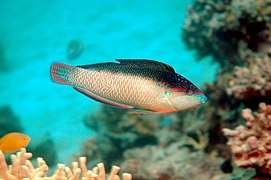Transvenidae
Transvenidae is a family of parasitic spiny-headed (or thorny-headed) worms in the order Echinorhynchida. This family contains three species divided into two genera.
| Transvenidae | |
|---|---|
| Scientific classification | |
| Kingdom: | Animalia |
| Phylum: | Acanthocephala |
| Class: | Palaeacanthocephala |
| Order: | Echinorhynchida |
| Family: | Transvenidae Pichelin & Cribb, 2001[1] |
Taxonomy and description
Phylogenetic analysis has been conducted.[2]
Species
There are three genera and six species in the family Transvenidae:[3][4][lower-alpha 1][lower-alpha 2]
Paratrajectura Amin, Heckmann et Ali, 2018
- Paratrajectura longcementglandatus Amin, Heckmann et Ali, 2018
Sclerocollum Schmidt and Paperna, 1978
- Sclerocollum robustum (Edmonds, 1964)
- Sclerocollum rubrimaris Schmidt and Paperna, 1978
- Sclerocollum saudii Al-Jahdali, 2010
Trajectura Pichelin & Cribb, 2001[1] Trajectura is distinguished by the possession of only two cement glands and an anterior conical projection (function unknown) on the females.[1]
- Trajectura ikedai (Machida, 1992)
Diplosentis ikedai was found to share similar anatomical features (only two cement glands and an anterior conical projection on females) was renamed T. ikedai.[1]
- Trajectura perinsolens Pichelin and Cribb, 2001
T. perinsolens Was found parasitising the New Guinea wrasse Anampses neoguinaicus from the Great Barrier Reef, Queensland, Australia.[1]
Transvena Pichelin & Cribb, 2001[1]
- Transvena annulospinosa Pichelin and Cribb, 2001
Hosts
- Hosts for Transvenidae species
 The New Guinea wrasse (Anampses neoguinaicus) is one of the hosts of T. perinsolens
The New Guinea wrasse (Anampses neoguinaicus) is one of the hosts of T. perinsolens
Notes
- A binomial authority in parentheses indicates that the species was originally described in a genus other than the present genus.
- Pararhadinorhynchus Johnston & Edmonds, 1947[5] including Pararhadinorhynchus magnus.[6] Pararhadinorhynchus is sometimes classified within the Diplosentidae.[6]
References
- Pichelin, S.; Cribb, T. (2001). "The status of the Diplosentidae (Acanthocephala: Palaeacanthocephala) and a new family of acanthocephalans from Australian wrasses (Pisces: Labridae)". Folia Parasitologica. 48 (4): 289–303. doi:10.14411/fp.2001.047.
- https://doi.org/10.2478/helm-2020-0007
- https://www.itis.gov/servlet/SingleRpt/SingleRpt?search_topic=TSN&search_value=993534#null
- Huston, D. C., Cribb, T. H., & Smales, L. R. (2020). Molecular characterisation of acanthocephalans from Australian marine teleosts: proposal of a new family, synonymy of another and transfer of taxa between orders. Systematic Parasitology, 1-23.
- Johnston, T. H.; Edmonds, S. J. (1947). "Australian Acanthocephala No. 5". Transactions of the Royal Society of Australia. 71: 13–19.
- Van Ha, Nguyen; Amin, Omar M.; Ngo, Ha Duy; Heckmann, Richard A. (2018). "Descriptions of acanthocephalans, Cathayacanthus spinitruncatus (Rhadinorhynchidae) male and Pararhadinorhynchus magnus n. sp. (Diplosentidae), from marine fish of Vietnam, with notes on Heterosentis holospinus (Arhythmacanthidae)". Parasite. 25: 35. doi:10.1051/parasite/2018032. ISSN 1776-1042. PMC 6057740. PMID 30040609.
